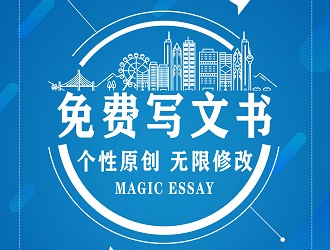留学文书范文|医科|个人陈述|PS|临床医学|10
嘉东/2020-01-21/ 分类:个人陈述PS/阅读:
To Have Fantasy Is To Be Fantastic Practicing piano playing ever since my childhood, I have always been enamored of one particular composition, short as it isthe one-minute Impromptus Fantasia by Fryderyk Franciszek Chopin. Upon embarking ...
To Have Fantasy Is To Be Fantastic
Practicing piano playing ever since my childhood, I have always been enamored of one particular composition, short as it is—the one-minute Impromptus Fantasia by Fryderyk Franciszek Chopin. Upon embarking on my undergraduate program in clinical medicine at the XX University (09/1999-06/2004), I thought that I would no longer indulge in the visionary world as portrayed by the Fantasia because I were to deal with hard-and-clear facts of science and I must subject myself to the spirit of scientific positivism. However, after so many years, I find that I have been wrong. The deeper I delve into my research on oncology, the more I find it necessary to combine the rationalism of science with the frame of mind of fantasy.
I believe that oncology is exactly the field where fantasy is needed more than ever. So many decades have passed since cancer was discovered to be a lethal disease and yet man still has not found effective therapeutic measures to defeat this major human killer. Mr. x x, a 28-year-old doctoral student under my father’s supervision who himself specialized in the genetic therapy of brain gliomas, died of the disease he was trying to prevail over. My father, director of China’s Neurosurgery Research Institute, often sighs with a sense of resignation: “As a neurosurgeon, I can only try my best to elongate the lifespan of my patients, not alter their death sentences.”
The prognosis of the patients suffering from malignant brain gliomas has not been markedly improved due to the recurrence of the tumor and the damage its invasive growth produces on the normal cerebral tissues in t he peripheral areas of the tumor. To address this root cause, there is still a long way to go. While well aware of the futility of the research efforts by any single researcher, as a student of neurosurgery I have already been performing my own research on cancer through novel approaches, believing that I may contribute to the overall human endeavors to combat against this deadly disease.
The experiment project XX that I undertook as a third-year undergraduate was related to potential therapy of the Gliomas. In this experiment, my research indicates that Kir2.1 is an α submit in the mutant potassium channel which can determine and stabilize the resting membrane potential in many types of cells. Kir2.1’s close connection with cellular growth and intercellular transduction triggered a series of reflections on my part—Can Kir2.1 also stabilize the potential of the glioma cells? Can its mutation suppress the growth of the glioma cells or induce their apoptosis? Can we hence develop an anti-glioma therapy? I exchanged those ideas of mine with Prof. XX of The university of XX, who not only expressed his interest in my concepts but also provided me with the Kir2.1 plasmids.
In my 5-year undergraduate program, this project was but the start of a series of researches on brain gliomas, an intracranial malignant tumor with the highest incidence and mortality rate. In an attempt to examine the possible effect of resveratrol on the stability of the potassium channel, I studied how resveratrol could contribute to the proliferation and apoptosis of brain glioma C6 cell line as well as fibroblast 3T3 cell line in vitro. Methyl thiagolyl tetragolium (MTT) assay was used to measure the effects on the proliferation of C6 and 3T3 cells cultured with different concentrations of resveratrol for 24h,48h,72h and 96h. HE staining, scanning electron microscope, TUNEL fluorescence staining and the annexin V assay by flow cytometer(FCM) were followed to detect the apoptosis induced by resveratrol. The results indicate that resveratrol obviously suppresses the proliferation(P<0.01) and induces the apoptosis of C6 with a typical apoptotic feature in vitro. Hence, resveratrol might be considered as a possible treatment strategy for brain gliomas. Based on those findings, I have published a research paper XX, a leading scholarly journal of the country.
Subsequent to this research, I have completed another research paper XX. In this research, expression of three cyclin D subtypes was defined immunohistochemically with cyclin D1/2/3 monoclonal antibodies in 52 glioma biopsies and 8 brain tissues as normal control. PCNA labeling indices were used to evaluate the proliferation activity of glioma cells. I found that only cyclin D1 expression was observed in normal brain tissues while marked overexpression of cyclin D1 and cyclin D3 were found in gliomas. This paper has been accepted by Journal of XX and will be published soon.
Throughout my undergraduate career, I distinguished myself not only in research but also in academic study. I was ranked top student in my class and top 5 in my grade (consisting 510 students). Among a number of honors and awards I have received, I am most proud of my being the winner of the President’s Scholarship for two consecutive academic years since its inauguration in 2002. As a student engaged in basic research, I have developed a solid grasp of experiment skills such as cell culture, immunohistochemistry, RT-PCR technique, PCR technique, zymogram analytical technique, patch clamp technique, etc.
Since Sept. this year, I have embarked on my Master’s program in neurosurgery. Apart from doing advanced coursework in medical statistics, experimental zoology, immunology, oncology, monoclonal antibody, I have been performing further research on resveratrol as a possible therapy of gliomas by focusing on the relationship between the Matrix Metalloproteinases and apoptosis of glioma cells, as it is well known that the Matrix Metalloproteinases play major role in the process of tumor invasion and metastasis.
Having accumulated important research experience, I wish to pursue a Ph.D. program which will allow me to perform advanced research in my area of specialization. I am interested in exploring the evolutionary process whereby normal brain cells develop into glioma cells, how glioma cells acquire invasive and metastatic properties and break through human defence mechanisms. I wish to know whether, in treating the malignant tumor, specific targets can be found to attack the tumor and induce it to develop into normal states. As malignant tumor depends on blood supply for life, are there any specific ways to block the blood supply and ultimately to cause the cell’s apoptosis?
Those are some of the fantasies of a maturing student in neurosurgery and I believe that the scientists of oncology worldwide, including those in the esteemed university of x x x , all share the ultimate fantasy— to reverse the malignant tumor cells into normal cells. Having attended XX held in August this year in XX, during which I worked as a conference volunteer and listened to the lecture “What Can We Do to Cure Cancer” by Prof.XX, I have become all the more determined to pursue in-depth and cutting-edge research in oncology. Apart from the research I have performed, I am well-informed of the latest research developments in international academia on gliomas—I have published two survey studies XXand XX. In your Ph.D. program, my primary objective is to develop fantasy with your first-rate researchers— to explore innovative ways of cancer research so as to achieve breakthroughs in a most challenging field. To have fantasy is to be fantastic.
I believe that oncology is exactly the field where fantasy is needed more than ever. So many decades have passed since cancer was discovered to be a lethal disease and yet man still has not found effective therapeutic measures to defeat this major human killer. Mr. x x, a 28-year-old doctoral student under my father’s supervision who himself specialized in the genetic therapy of brain gliomas, died of the disease he was trying to prevail over. My father, director of China’s Neurosurgery Research Institute, often sighs with a sense of resignation: “As a neurosurgeon, I can only try my best to elongate the lifespan of my patients, not alter their death sentences.”
The prognosis of the patients suffering from malignant brain gliomas has not been markedly improved due to the recurrence of the tumor and the damage its invasive growth produces on the normal cerebral tissues in t he peripheral areas of the tumor. To address this root cause, there is still a long way to go. While well aware of the futility of the research efforts by any single researcher, as a student of neurosurgery I have already been performing my own research on cancer through novel approaches, believing that I may contribute to the overall human endeavors to combat against this deadly disease.
The experiment project XX that I undertook as a third-year undergraduate was related to potential therapy of the Gliomas. In this experiment, my research indicates that Kir2.1 is an α submit in the mutant potassium channel which can determine and stabilize the resting membrane potential in many types of cells. Kir2.1’s close connection with cellular growth and intercellular transduction triggered a series of reflections on my part—Can Kir2.1 also stabilize the potential of the glioma cells? Can its mutation suppress the growth of the glioma cells or induce their apoptosis? Can we hence develop an anti-glioma therapy? I exchanged those ideas of mine with Prof. XX of The university of XX, who not only expressed his interest in my concepts but also provided me with the Kir2.1 plasmids.
In my 5-year undergraduate program, this project was but the start of a series of researches on brain gliomas, an intracranial malignant tumor with the highest incidence and mortality rate. In an attempt to examine the possible effect of resveratrol on the stability of the potassium channel, I studied how resveratrol could contribute to the proliferation and apoptosis of brain glioma C6 cell line as well as fibroblast 3T3 cell line in vitro. Methyl thiagolyl tetragolium (MTT) assay was used to measure the effects on the proliferation of C6 and 3T3 cells cultured with different concentrations of resveratrol for 24h,48h,72h and 96h. HE staining, scanning electron microscope, TUNEL fluorescence staining and the annexin V assay by flow cytometer(FCM) were followed to detect the apoptosis induced by resveratrol. The results indicate that resveratrol obviously suppresses the proliferation(P<0.01) and induces the apoptosis of C6 with a typical apoptotic feature in vitro. Hence, resveratrol might be considered as a possible treatment strategy for brain gliomas. Based on those findings, I have published a research paper XX, a leading scholarly journal of the country.
Subsequent to this research, I have completed another research paper XX. In this research, expression of three cyclin D subtypes was defined immunohistochemically with cyclin D1/2/3 monoclonal antibodies in 52 glioma biopsies and 8 brain tissues as normal control. PCNA labeling indices were used to evaluate the proliferation activity of glioma cells. I found that only cyclin D1 expression was observed in normal brain tissues while marked overexpression of cyclin D1 and cyclin D3 were found in gliomas. This paper has been accepted by Journal of XX and will be published soon.
Throughout my undergraduate career, I distinguished myself not only in research but also in academic study. I was ranked top student in my class and top 5 in my grade (consisting 510 students). Among a number of honors and awards I have received, I am most proud of my being the winner of the President’s Scholarship for two consecutive academic years since its inauguration in 2002. As a student engaged in basic research, I have developed a solid grasp of experiment skills such as cell culture, immunohistochemistry, RT-PCR technique, PCR technique, zymogram analytical technique, patch clamp technique, etc.
Since Sept. this year, I have embarked on my Master’s program in neurosurgery. Apart from doing advanced coursework in medical statistics, experimental zoology, immunology, oncology, monoclonal antibody, I have been performing further research on resveratrol as a possible therapy of gliomas by focusing on the relationship between the Matrix Metalloproteinases and apoptosis of glioma cells, as it is well known that the Matrix Metalloproteinases play major role in the process of tumor invasion and metastasis.
Having accumulated important research experience, I wish to pursue a Ph.D. program which will allow me to perform advanced research in my area of specialization. I am interested in exploring the evolutionary process whereby normal brain cells develop into glioma cells, how glioma cells acquire invasive and metastatic properties and break through human defence mechanisms. I wish to know whether, in treating the malignant tumor, specific targets can be found to attack the tumor and induce it to develop into normal states. As malignant tumor depends on blood supply for life, are there any specific ways to block the blood supply and ultimately to cause the cell’s apoptosis?
Those are some of the fantasies of a maturing student in neurosurgery and I believe that the scientists of oncology worldwide, including those in the esteemed university of x x x , all share the ultimate fantasy— to reverse the malignant tumor cells into normal cells. Having attended XX held in August this year in XX, during which I worked as a conference volunteer and listened to the lecture “What Can We Do to Cure Cancer” by Prof.XX, I have become all the more determined to pursue in-depth and cutting-edge research in oncology. Apart from the research I have performed, I am well-informed of the latest research developments in international academia on gliomas—I have published two survey studies XXand XX. In your Ph.D. program, my primary objective is to develop fantasy with your first-rate researchers— to explore innovative ways of cancer research so as to achieve breakthroughs in a most challenging field. To have fantasy is to be fantastic.
此文书内容来源于网络,若侵犯权益,请及时联系我们!
若需要更多的文书范文也请联系我们!
-
VIP咨询

免费申请/获取文书范文加上方微信
-
微信公众号

更多免费申请信息请关注上方公众号
版权声明 本文仅代表作者观点,不代表本站立场。
本文系作者授权本站发表,未经许可,不得转载。
本文系作者授权本站发表,未经许可,不得转载。
扩展阅读:





